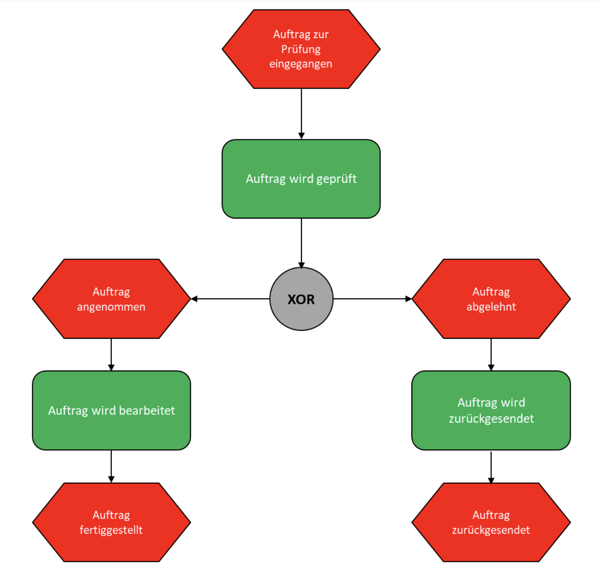Simultaneous engineering - definition, development and procedure
Simultaneous engineering is a method to shorten the time from the idea of the product to the market launch.
The event-driven process chain (EPC) as a graphical model language is used for the systematic representation of business processes. These processes are created using defined syntax rules and a semiformal modeling language.
In the following article you will get all important information and a definition of the event-driven process chain and relevant symbols and objects. In addition, we name the most important rules of the EPC, explain the extended event-driven process chain and give a concrete EPC example and a guide for EPC creation.

The Event Driven Process Chain (EPC) is a graphical model language that is used to systematically represent the business processes of a company or organization.
The method was developed by August-Wilhelm Scheer in 1992 as an essential part of the ARIS concept. ARIS stands for "Architecture of Integrated Information Systems". Common applications of EPC include process documentation, assignment of responsibilities, activity-based costing, and analysis and optimization of business processes.
Die grundlegende Idee des Konzeptes liegt darin, Arbeitsprozesse mithilfe von definierten Syntaxregeln und einer semiformalen Modellierungssprache grafisch darzustellen. Grundsätzlich findet die Modellierung eines EPK-Modells von oben nach unten statt. Eine EPK besteht aus drei unterschiedlichen Elementen:
The basic idea of the concept is to graphically represent work processes using defined syntax rules and a semiformal modeling language. Basically, the modeling of an EPC model takes place from top to bottom. An EPC consists of three different elements:
Unter einem Ereignis versteht man das Eintreten eines betriebswirtschaftlichen Zustandes, der eine Aktivität auslöst. Dagegen ist eine Funktion eine Aktivität, die ein Ereignis auslöst. Die drei logischen Konnektoren (UND, ODER und XOR) verbinden Ereignis und Funktion miteinander.
An event is the occurrence of a business condition that triggers an activity. In contrast, a function is an activity that triggers an event. The three logical connectors (AND, OR and XOR) link event and function.
An EPC must inevitably begin with an event and end with an event. Essential aspects are the representation of the control flow, the representation of concurrency / parallelism of conditional branches and loops, as well as the reproduction of the data flow.
In the case of the extended event-driven process chain (eEPC), the organizational units and information systems involved are also specified. An EPK is not predestined for a formal illustration, since properties for a transformation into another notation are not given.
In addition to the three elementary components of any EPC already mentioned, there are other important EPC symbols and objects. In the following, in addition to function, event and connectors, we also explain connection arrows, AND link, OR link (inclusive OR), XOR link (exclusive OR) and process signpost. The Organizational Unit and Information Object objects are exclusive to eEPC.
A function specifies what happens or should be done after a triggering event (Ex: "Process order"). Each activity to be performed in and during a business process must be modeled as a function. Each EPC must contain at least one function. A function is capable of having a maximum of one input and two outputs / two inputs and one output.
In an EPC, an event represents a relevant state for business management and information technology (e.g. "order received"). It is an occurred state within a business process. As a rule, it is followed by further process steps.
Events are significant elements for the control of an organization or a company. Normally, a process chain begins and ends with an event. Function and event usually occur alternately, but there is usually a connector in between. An event may have a maximum of one input and two outputs / two inputs and one output.
A connector arrow indicates the flow of an EPC. As a rule, an EPC runs from top to bottom and is represented in this way. The connecting arrow is a directional arrow that connects two elements.
Connectors are logical links between functions and events. Here we distinguish between the three different connectors ("OR", "AND" and "XOR"). All connectors may have either only one input line but several output lines, or only one output line but several input lines.
An AND connector specifies that all functions or events must occur to trigger the subsequent event or function.
The OR connector specifies that at least one event or function must occur (but more than one may occur) for the subsequent event or function to be triggered.
The XOR connector specifies that at least exactly one event or function may occur to trigger the subsequent event or function.
The organizational unit indicates which person performs a function. An organizational unit can only be associated with one function.
Informationsobjekte geben die Daten an, die für die Durchführung einer Funktion notwendig sein. Ein Informationsobjekt kann nur mit einer Funktion verbunden werden.
Information objects specify the data that is required to perform a function. An information object can only be associated with one function.
A process signpost makes it possible to link individual business processes.
In order to guarantee the smooth flow of an event-driven process chain, certain rules must be observed. These rules apply partly in general, partly they refer explicitly to certain EPC symbols or objects.
The extended event-driven process chain (eEPC) is, as the name suggests, an extended version of the EPC modeling language. As with EPC, eEPC is used to systematically capture business processes in companies or organizations. In addition to the already known symbols of the EPC, the eEPC is supplemented by further elements, such as an organizational unit and an information object.
The application areas of the eEPK and the event-driven process chain overlap. The choice of the two modeling languages depends on whether the organizational unit or the information used for the representation is to be modeled. If the modeling of these two elements is required, users will need to resort to the extended event-driven process chain.
An extended event-driven process chain, like an EPC, serves the needs of non-formal practices. Basically, an eEPC maps parallel sequences of branches and loops or the representation of the control flow. It also reflects the flow of data and indicates which organizational units and information objects take place amid an eEPC.
Extended event-driven process chains consist of standardized symbols and elements. However, they are not suitable for a formal representation because they cannot be converted into formal notations.
An EPC example could be the following, visualized in the following.

The following guide makes it easy to create an event-driven process chain.
As with pretty much everything, EPCs have specific advantages and disadvantages. In the following, we briefly discuss some of them.
Event-driven process chains are characterized in particular by their easy readability as well as their user-friendly operability. The user-friendly modeling language enables people who are not IT experts to quickly understand and learn it.
An EPC can be analyzed accurately due to the visualization of the process, the simple clarity and the intuitive comprehensibility. Furthermore, these characteristics form the basis for learning how to analyze and represent an EPK. An accurate representation of processes can be implemented through an EPC. The fact that an EPC is a quasi-industry standard underlines this.
EPCs are offered by various applications and supported by a wide range of tools. Thus, there are many possibilities to create EPCs easily and without much effort. A clear visualization of the dependency of events and functions is much easier compared to other representation methods.
The few and unambiguous rules ensure that the creation of an EPK involves little work. The status of a process is consistently transparent due to the sequence of an event on a function.
EPCs have a shortcoming in the trainability of creative and complex processes. In addition, the representation of monitoring activities is problematic and cannot be easily mapped.
Whether the rule of having an event follow a function is actually useful can be questioned upon closer examination. Compared to an eEPC, an EPC neglects the person performing the activity. In addition, EPCs do not show how long the waiting times or throughput times of a process are.
Finally, there is the possibility that the top-down modeling leads to a confusing representation and confuses the viewer.
With the help of an event-driven process chain (EPK), business processes can be logically captured and visually represented. Furthermore, an EPC is a modeling language that is used for the previous purposes. The classic elements and symbols of an EPC represent events, functions and link connectors. In the application case, EPCs are usually used for process documentation or for the analysis and optimization of processes in companies.
Basically, an EPC begins and ends with an event. The structure of an EPC follows the top-down principle and is therefore read from top to bottom. An event is followed by a function. These two elements are connected by a logical connector.
An EPC is first created by thinking about the desired process. Then one writes an unordered list of all possible events and functions and considers all necessary connectors. Then a desired sequence is determined and a tool for modeling is selected. Finally, all symbols are finalized and the EPK is arranged in the desired order.
EPC and eEPC have little to no differences. As the name implies, the extended event-driven process chain is simply an extension of the existing modeling language. The only notable difference is the two added elements of "organizational unit" and "information object".
Simultaneous engineering is a method to shorten the time from the idea of the product to the market launch.
Technical drawing: definition, basics, rules & standards and free programs for technical drawing.
Detailed information about Robotic Process Automation (RPA): definition, functions, tasks & application areas. RPA Software & Tools. Learn more ✅